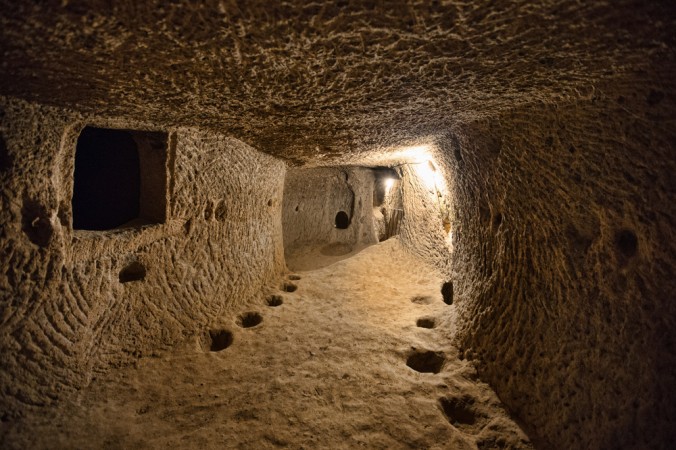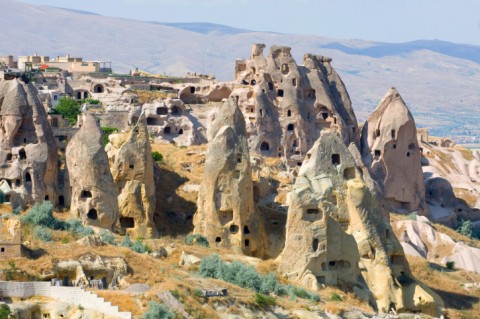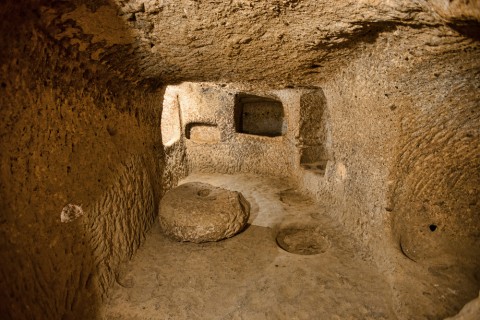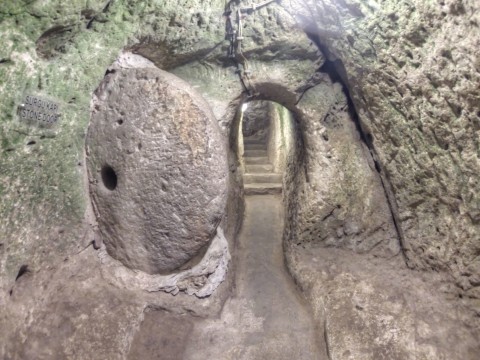Who Built the Underground City of Derinkuyu?
HISTORY, 2 Mar 2015
In the Cappadocia region of Turkey there is a town called Derinkuyu; and beneath Derinkuyu there is a city, vast and deep, of ancient design, preserved to this day. The mystery of who built it and why remains, although scholars have their theories.
The region of Cappadocia is well known around the world for its vast labyrinths of underground cities. Above ground, the region is equally impressive. The landscape is peppered with ancient volcanic stone chimneys, known as “fairy chimneys.” Over the years, as civilizations and peoples have come and gone, the varying cultures carved intricate structures into and out of these chimneys making for very unique and impressive architecture.
“Although the area has been extensively used and modified by man for centuries, the resulting landscape is one of harmony and consideration of the intrinsic values of the natural landforms,” according to the United Nations Education, Scientific, and Cultural Organization (UNESCO) webpage on the “Göreme National Park and the Rock Sites of Cappadocia.”
The underground cities of Cappadocia number about 200 and are spread across the entire region. It’s possible there could be more lying below the surface, waiting to be discovered.
Of all the underground cities discovered so far, the most awe-inspiring is perhaps the Derinkuyu underground city. It was discovered by accident in 1963, when a local family was renovating a house and a wall gave way to reveal a room and passage that led to this underground network.
Size and Structure of the Derinkuyu Underground City
It is 11 levels, according to National Geographic, descending about 280 feet, with an area of a little over 4 miles squared (6.5 kilometers squared).
It includes chambers for various daily activities, including temples, tombs, shops, living quarters, and even livestock pens. It has 15,000 air shafts, and enough room to comfortably hold approximately 20,000 people.
Additionally, the underground city has extending passages that connect it to other local underground networks, as well as wineries, underground water well systems providing fresh water, and a security system consisting of gigantic rolling stone doors that could seal the city from the inside. Moreover, each level could be sealed off from the next level using the same system.
The structure is carved into the underground rock and is strong enough after countless years to safely accommodate guests, such as archaeologists and tourists. Although the stone is relatively soft, there has been no evidence of any cave-ins throughout the site, suggesting that whoever built the network had an advanced knowledge of the stone, stonework, architecture, engineering, and the local geography.
But, who exactly did built this city and why?
Was it Ancient Christians? A Prehistoric King Protecting His People from Disaster?
Aging the structure has proved very difficult, as the structure was carved out of stone. Thus, there are no quarries to examine. Furthermore, there are no records documenting the construction, and the peoples who have lived there have long since vanished or moved on.
Moreover, many cultures have used the underground towns over the centuries. Probably the most recent group to stay in the caverns are the early Christians, but there is little reason to assume they built the caverns.
“It is believed that the first signs of monastic activity in Cappadocia date back to the 4th century, at which time, acting on the instructions of Basil the Great, Bishop of Caesarea (Kayseri), small anchoritic communities began inhabiting cells dug into the rock,” according to UNESCO. “Later on, in order to resist Arab forays they began banding together into troglodyte villages or subterranean towns such as Kaymakl or Derinkuyu, which served as places of refuge.”
It’s possible that the Phrygian people could have constructed the underground city around 800 B.C., as they occupied that area at the time.
Another theory suggests that the city was constructed by the Hittites in about the 14th century B.C., while retreating from the invading Phrygians, according to the “Encyclopedia of Architectural and Engineering Feats.”
However, some believe that the underground city is even older than that. It’s suggested that that caves were constructed by the Persian King Yima. Yima may have been a mythological figure rather than an actual king, he is said to have had a lifespan of more than 900 years; this long lifespan is a common feature of Biblical figures as well. The Zoroastrian text “Vendidad” states that Yima built an underground city on the orders of the god Ahura Mazda, to protect his people from a catastrophic winter. Much like the account of Noah in the Bible, Yima was instructed to collect pairs of the best animals and people as well as the best seeds in order to reseed the Earth after the winter cataclysm.
The “Vendidad” was composed over the course of many centuries, possibly beginning before the 8th century B.C., though the stories may have been passed down orally well before that. It’s hard to tell when the story of Yima’s underground city emerged. Some say the “winter” could refer to an ice age.
However, if this is true, the last ice age was between 110,000 to 10,000 years ago, placing the construction of the Derinkuyu underground city in remote pre-history, if the “Vendidad” is indeed referring to this city. The “Vendidad” could have also been referring to all of Cappadocia’s great underground cities as a possible sanctuary from destruction.
Another theory holds that the structure could have been built as protection from invading forces. The labyrinth’s security doors support that theory. However, such a vast network would have taken an immense amount of time to construct without advanced tools. Masons might have had very limited time to complete the task if they were working under threat of invasion, and the craftsmanship behind Derinkuyu would suggest otherwise. The network could have been hastily constructed originally, however, then added to over and over again with each group that came through.
______________________________
More:
- 10 Amazing Subterranean Structures From the Ancient World
- Did Ancient People Really Have Lifespans Longer Than 200 Years?
Visit the Epoch Times Beyond Science page on Facebook and subscribe to the Beyond Science newsletter to continue exploring ancient mysteries and the new frontiers of science!
Update: An earlier version of this article stated that the underground city has eight levels rather than 11. Some sources have stated that it has eight levels, perhaps because other levels were only partially excavated.
Go to Original – theepochtimes.com
DISCLAIMER: The statements, views and opinions expressed in pieces republished here are solely those of the authors and do not necessarily represent those of TMS. In accordance with title 17 U.S.C. section 107, this material is distributed without profit to those who have expressed a prior interest in receiving the included information for research and educational purposes. TMS has no affiliation whatsoever with the originator of this article nor is TMS endorsed or sponsored by the originator. “GO TO ORIGINAL” links are provided as a convenience to our readers and allow for verification of authenticity. However, as originating pages are often updated by their originating host sites, the versions posted may not match the versions our readers view when clicking the “GO TO ORIGINAL” links. This site contains copyrighted material the use of which has not always been specifically authorized by the copyright owner. We are making such material available in our efforts to advance understanding of environmental, political, human rights, economic, democracy, scientific, and social justice issues, etc. We believe this constitutes a ‘fair use’ of any such copyrighted material as provided for in section 107 of the US Copyright Law. In accordance with Title 17 U.S.C. Section 107, the material on this site is distributed without profit to those who have expressed a prior interest in receiving the included information for research and educational purposes. For more information go to: http://www.law.cornell.edu/uscode/17/107.shtml. If you wish to use copyrighted material from this site for purposes of your own that go beyond ‘fair use’, you must obtain permission from the copyright owner.



